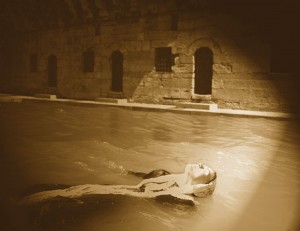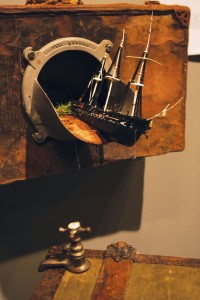Tom Sale smells a rat. He’s holding the stiff, dried-out corpse right under his nose, just unpacked from a box of other animal remains, including several skulls and two flattened frogs.
“I don’t smell anything,” Sale says, and puts the former rodent down on top of a vintage glass display case. “Maybe it’s cloves or some herbs I put in here.”
Or the gold paint covering the critter, perhaps. The rat appears to have been frozen in mid-squeak; like the other animals in the box, it is covered by a thick coat of gold paint.

No animals were harmed in the creation of this gilded menagerie, Sale points out — these were found either by him, his wife, or friends who know his interests. “People think I am the go-to guy for anything disgusting, macabre, and bloody,” Sale said. “That is not true. I love a good image of a skeleton, and I like those other things if they are historic, clever, or beautifully done.”
The shiny animal remains are destined to be hung in a grid opposite the gallery’s large front windows. Another wall grid features 12 framed sentences, printed via an old-fashioned press to reflect the period, labeled: “Never before seen quotes from Florence Nightingale’s private journals from age 6 to 84.”
It’s a week before the opening, so Sale is installing the show in the Webb Gallery’s 10,000-square-foot historic brick building just off Waxahachie’s courthouse square. Sale is wearing a plaid shirt, rumpled slacks, and mismatched socks. He moves quietly and thoughtfully among vaguely organized groupings of his art and acquisitions.
Frank Eberle, Sale’s neighbor and friend, is moving around the room armed with a level and a drill. His carpentry skills are essential. There are dozens of things to be hung — shadow boxes, framed photographs, antique steamer trunks with dioramas inside, maps, a collection of vintage shears and scissors. The gallery walls will be filled, and Sale is using most of the floor space as well.
“How does this look?” Eberle asks as he positions an antique wooden case that could have held a musical instrument.
About 75 percent of the exhibit consists of Sale’s own work, though much of that is his re-purposing of found objects.
“This amazing Victorian wheelchair I found, with wicker seat and hand-tooled leather decoration, will be a centerpiece,” Sale said. There are glass display cases and antique tables where objects, including 13 human big toes and 13 thumbs cast in pewter, will be spread out for viewing. One case will feature handmade pillows that Sale said nurses made to support the many amputees in the army hospitals.
He talks about how the barracks hospitals and Constantinople in general were overrun with rats and cats. In a corner a small mannequin is dressed in a replica of one of Nightingale’s simple black Victorian dresses.
Hundreds of French knots, embroidered with red thread, seem to form a map on the back of the dress. “I sewed those,” Sale said. “Each French knot represents 50 cats. That’s how enormous the cat population was at that time.”
The dress also figures prominently in a series of photographs Sale staged and directed while a photographer friend, Dylan Hollingsworth, did the shooting. Romantic and ethereal sepia-tinted prints show Sale’s friend, Amie Carson, portraying a young Nightingale floating in a body of water meant to represent the Bosphorus Straits.
“That’s a stock pond near my farm in Bardwell,” Sale says with a grin. Portraits of an older Florence, played by fellow artist Vetter, depict the nurse’s later years in shadowy rooms of a Victorian house.
“This was an art and storytelling imperative for me,” Sale says. “For instance, I learned that Florence influenced hygiene reform, fresh water, and irrigation in India on one of her many consulting trips. So I immediately went to Old Home Supply in Fort Worth to find 19th-century pipe fittings.” He used the plumbing parts as peepholes through which gallery-goers can view the scenes featuring tiny figures inside the antique trunks.
He seems bent on walking a thin creative line of his own making. It’s a personal tightrope without a net.
“I don’t know,” he says, smiling. “I’m proud of this, but I think I have 10 good years left in me.”
********
It was a fluke that brought Julie and Bruce Webb to Waxahachie, one of those Texas towns whose names national news anchors always struggle to pronounce. Native Texans who both ended up living in Dallas, they married in 1985 and moved to Waxahachie the next year, when Bruce inherited his grandparents’ home there.
They shared a background in art and antiques and a love for collecting. What started as a passionate hunt for old handmade objects — fraternal lodge items, carnival banners, tramp art, quilts — became a quest for what Julie calls “killer oddball stuff and anything unusual.”

They travel and collect, meeting artists and craft-makers throughout the Southwest, the Southeast, and the Midwest, with frequent trips crisscrossing Texas. At first they sold their finds at craft and art fairs in Canton and at the then-monthly flea market in Dallas’ Fair Park. “We met Tom and Dottie many years ago, when they were doing most of the same things,” Bruce said. “We all got to be good friends.”
By 1987 the Webbs’ collections had outgrown their home. A large building on Franklin Street was available. “It was built in 1902 and originally housed a paint and wallpaper company,” Bruce said. “Upstairs was the local phone company.” He liked the connections with decorative arts and communication. They bought and renovated it.
The Webb Gallery became part of Waxahachie’s downtown scene. Gallery offerings grew more varied as the Webbs discovered the work of “outsider” artists, people with a self-taught need to express themselves via visual art. Some outsider artists are rebels, some mentally challenged, some on the edge of healthy psychology. Some have lived on the street.
What they have in common, Julie Webb said, is “the intense drive to produce these images, to reveal their lives and their environments, to tell their personal stories. Most of these folks used whatever materials were at hand, and many are not traditional media. We have work made by a man who used his own saliva mixed with dried tempura to make paint.”
She’s talking about Chicago-based Stephen Warde Anderson, who paints pictures of old Hollywood glamazons’ heads on top of animal bodies. The Webbs have artwork by Burroughs, best known as a writer but who also made photographs, photo collages, and drawings.
“Bruce and I grew up in the punk rock scene,” Julie said. “We were always interested in the subversives and people of independent thought.” They visited Burroughs in Lawrence, Kan., and showed his work in 1996 at their gallery. He died the next year, and the catalog of Burroughs’ life’s work compiled by the Los Angeles Museum of Art, called Ports of Entry, lists the Webb Gallery show as his last exhibit.
The Webbs represent Esther Pearl Watson, Jimmy Lee Sudduth, and dozens of other unique artists. A quarter- century in, the Webb Gallery houses a huge collection of such outsider art, plus antiques and rare collectibles. Between exhibits, Julie said, “we try to come up with musical performance events, films, speakers, and parties.”
Even though the Webb Gallery is somewhat off the beaten path, it holds a respected place in the North Texas arts community. The Webbs are considered experts in a niche art market, with a focus and concentration rarely seen in Texas.
When Sale started talking about The Florence Project, they immediately saw how it could fit into their gallery’s mission. Sale said Julie became a planning partner.
“She was a wonderful sounding board,” he said. “She served as my editor. That became more and more critical as we went along.”
“He had way too many ideas at first, and so many of them had great potential,” Julie Webb said. “I knew quickly that he was going to have to hone his story and his visual objectives. We have a lot of space but not nearly enough for most of his original vision.
“There is so much to see and to think about in The Florence Project,” Julie said, “so I’m sure people will visit Tom’s work here at least twice. It will take some time and revisiting.”
Sale will be at the Webb Gallery from 1 to 5 p.m. on Nov. 9. The exhibit will be shown each weekend through Jan. 29 and by appointment.
“I will try not to hover as the viewers go through the show,” Sale said. “But if one of them asks me a question, look out!”
[box_info]
The Florence Project
Artifacts from the Adventures of Florence Nightingale
Collected by Tom Sale
The Webb Gallery
209 W. Franklin, Waxahachie, Texas 75165
Showing through January 29, 2014
Open Saturdays and Sundays from 1 to 5 and by appointment.
Webbartgallery.com
Phone: 972-938-8085
[/box_info]
North Texas freelance writer Annabelle Massey Malloy can be reached at annabellemm@sbcglobal.net.












Tom Sale is an inspiration.
Fresh out of high school I was lucky to have a class at UNT conducted by Mr. Sale, and it undoubtably help set me in the right direction.
Huge fan.
Future Eagle Don Henley & I were lucky enough to have Tom Sale’s dad (Dr. Richard Sale) as a professor at North Texas.